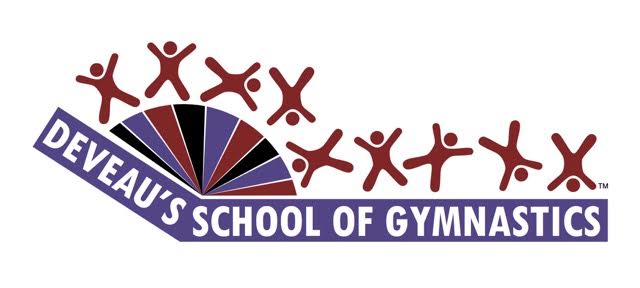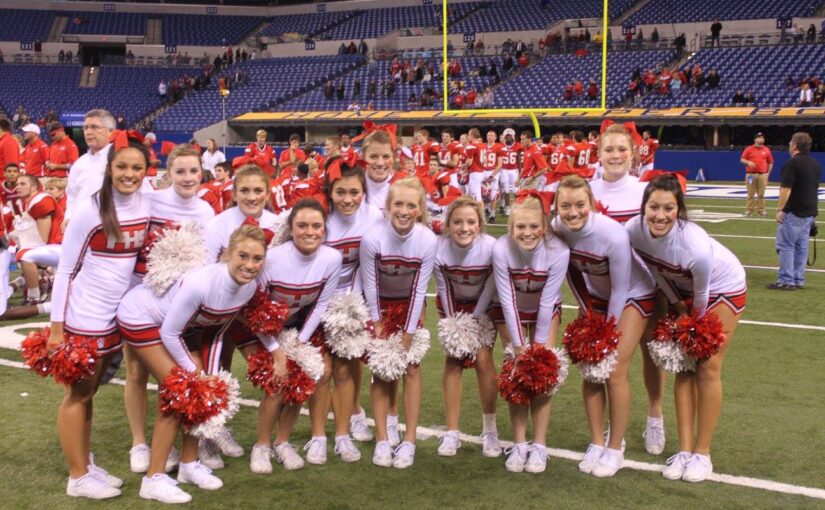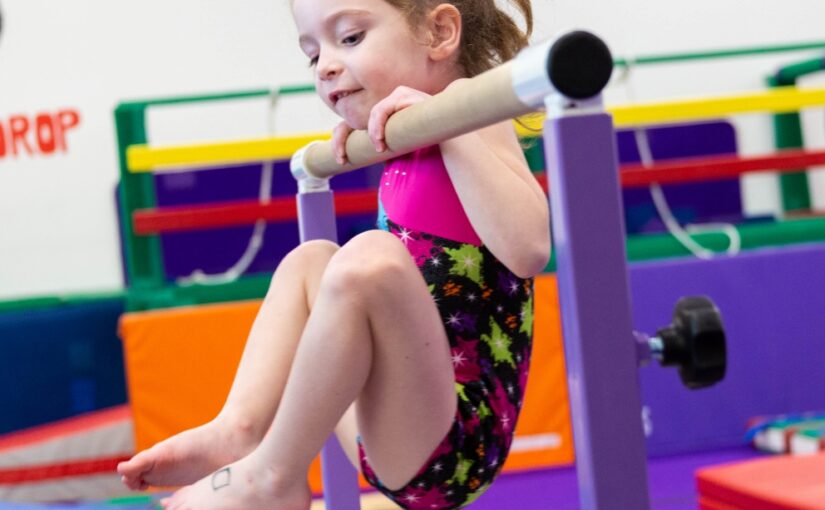Happy spring! It’s that time of year again when high school students start to stress and realize they need to sign back up for tumbling classes. We are often asked to teach a back handspring or a back tuck within just a couple of weeks. We really hate to disappoint kids when they realize these skills take more than a couple of weeks to learn. It’s even more disappointing for them to realize just how quickly they can lose their tumbling skills without continued conditioning and practice. Despite the possible heartaches, we love getting a front-row seat to this exciting time of year and helping as many kids fulfill their dreams as possible.
 High school cheerleading teams in the Indianapolis area have been very difficult to make for decades. The kids keep getting stronger and the talent keeps growing. As a cheerleading and gymnastics coach, I am often asked what the best route for a young child is if she wants to become a part of a high school cheerleading team one day.
High school cheerleading teams in the Indianapolis area have been very difficult to make for decades. The kids keep getting stronger and the talent keeps growing. As a cheerleading and gymnastics coach, I am often asked what the best route for a young child is if she wants to become a part of a high school cheerleading team one day.
With the strong legacy of high school cheerleading in Indiana, it isn’t unreasonable to begin preparing early, even as young as 7. There are many different paths one can take within those formative years to acquire the necessary skill set to make a local high school cheerleading team. The thing these paths all have in common is a dedicated structure including skill training, strength, and flexibility.
I’m hopeful that this post can answer many parents’ questions and help avoid potential heartaches years from now.
History of High School Cheerleading in Indiana
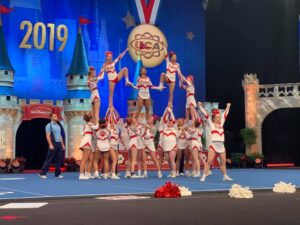
Many High School Cheerleading Programs in Indiana offer both competitive and non-competitive options, but all programs’ first priority is to support their athletic teams in their game day functions. For most schools in the area, the competitive cheerleading teams coincide with the football season and the non-competitive options coincide with basketball season. This also works out well to allow athletes the option to all participate in All-Star Competitive Cheerleading or Gymnastics because their competitive seasons follow high school cheerleading’s competitive season.
While many programs also compete at UCA High School Nationals in Orlando, Florida (Fishers High School Large Varsity Division 1 Champions in 2017, Hamilton Southeastern Non-Building in 2014), we’re going to track the Indiana State Cheer Championship. In the fall, Indiana High Schools compete against each other based on the population of their student body. Since at least 1991, the Indiana Association of School Principals (IASP) has conducted the Indiana State Cheer Championship where Junior High and High Schools are able to compete against each other in a routine format where athletes demonstrate their stunting, tumbling, jumping, and dancing abilities. When summarizing their results, it is important to note that my findings may not be 100% accurate because a couple years are missing results in the 1990s.
It is fun to see that the same schools that were competitive in 1991 – Hamilton Southeastern, Mt. Vernon, and Noblesville – are still some of the top teams in the state today. In Junior High, your top 3 teams historically are Mount Vernon Junior High with at least 11 wins, HSE Junior High with at least 8 wins, and Pendleton Heights Junior High with at least 6 wins. Other competitive programs over the years are Jasper Junior High, Fall Creek Junior High, and Carmel Middle School.

* Statistics gathered from iasp.org and 1992, 1994, and 1995 are missing from the data
Throughout the years, high schools have been reclassified based on their student body population. Without including the new Game Day division and Freshman or Junior Varsity divisions, the top Varsity State Championship Programs are Hamilton Southeastern with 10 wins, Bishop Dwenger with 8 wins, Pendleton Heights with 7 wins, Jasper with 6 wins, and Fishers High School, Mount Vernon High School, Noblesville, and Highland Senior High School with 5 wins. See the chart below for additional details.* Statistics gathered from iasp.org and 1992, 1994, and 1995 are missing from the data.

* Statistics gathered from iasp.org and 1992, 1994, and 1995 are missing from the data
What is Required to Be a Cheerleader Now
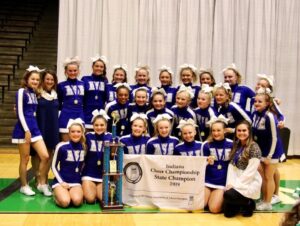 When considering what it takes to make a competitive high school cheerleading team, I thought it would be wise to ask some of the best coaches around. Coach Brenda Jamerson has coached Pendleton Heights High School for the past 19 years. She has led the team to compete under IASP and gain 8 Varsity State Championship titles and 11 State Stunt Group Championship titles.
When considering what it takes to make a competitive high school cheerleading team, I thought it would be wise to ask some of the best coaches around. Coach Brenda Jamerson has coached Pendleton Heights High School for the past 19 years. She has led the team to compete under IASP and gain 8 Varsity State Championship titles and 11 State Stunt Group Championship titles.
When noting what she looks for at tryouts, Coach Jamerson states, “I look for athletes! They have to understand hard work, how to take criticism and improve from it, how to be a team player and flexible in (stunting and formation) positions.” For her competitive team, Coach Jamerson requires athletes to be well rounded and “prefers strong stunters” or if they are able to indicate that they will learn stunting technique quickly as well as strong tumbling—noting that a standing back tuck is the minimum skill required to make the team.
Additionally, competitive cheerleaders also have to enjoy game day cheerleading as her team practices three times per week and use games as a time to practice their skills as well. Pendleton Heights cheerleaders cheer for football, girls and boys basketball, and compete at both the state and national level. Coach Jamerson is retiring from Pendleton Heights after this year but will continue her coaching legacy at Butler University.
Danielle Thompson is the Head Coach at Fishers High School who has had a very successful program since the Freshman campus opened in 2004. Similar to Coach Jamerson, Coach Thompson’s first requirement is that the potential candidates are “coachable athletes” or are able to “listen and are responsive to our coaching staff.” Not only is Coach Thompson making sure they are able to work well with other teammates, she also wants to be sure they are “well-rounded athletes.” She says: “Since this is a competitive sport, mental toughness plays a role as well. It is important athletes can handle the pressure of competing and trusting themselves and their teammates.”
A recent Fishers Cheerleader and volunteer coach, Taylor Giunta, notes that “just because someone can do something right away and you can’t, it doesn’t mean that you won’t be able to one day. It just takes time and dedication.” Time and dedication is certainly needed to accomplish the standing back tuck necessary to make Varsity at Fishers High School, whereas a back handspring is required to make Junior Varsity.
Coach Ally Stein is the head coach of 10-Time State Champions Hamilton Southeastern High School and has some of the stricter standards requiring three to four jumps to a standing tuck to make Varsity. HSE has a strong legacy to uphold; they have had many Varsity teams throughout the years with squad roundoff back-handspring fulls (or full twisting layouts). However, it is important to note that IASP has made a whip through to tuck equally as important on the scoresheet as a full. Coach Stein stresses the importance of attitude, stating:
We look for athletes who have a positive attitude and are kind to one another. We are all a part of the HSE Cheer Family; we have a very successful and strong history that we want to make sure our current athletes uphold. While teaching new skills to the athletes is important, we want to embody what a game day cheerleader looks like in front of a crowd and how they can be a leader on the sideline of football games.
As far as basketball cheerleading is concerned, Coach Stein notes that basketball cheerleading “is a separate program that is able to provide more athletes the opportunity to be an HSE cheerleader.” The basketball program at HSE does not participate in competitions, but it does provide cheerleaders an opportunity to “showcase their abilities in a routine style of performance.” When providing advice for an athlete who wants to cheer in high school one day, Coach Stein recommends:
My advice would be to attend the open gyms to get a feel for how the program works and if it is something you can see yourself being a part of. There are different cheer programs at the school to meet each athlete’s needs and desires. I would make sure the athletes know that we are watching their academics, athleticism, attitude, and appearance, as well as whether they are coachable and how they interact with their peers. All in all, we want to make sure it is a positive experience for all athletes to be a part of!
How to Make The Team
 There are a few different paths that kids can take to become a high school cheerleader one day, but a common denominator is that they have been developing their skillset for many years and are confident in their abilities. Whether one is part of a competitive program or a game-day cheerleader, the athlete has to be confident in their ability to lead the crowd through their voice, motions, and skills.
There are a few different paths that kids can take to become a high school cheerleader one day, but a common denominator is that they have been developing their skillset for many years and are confident in their abilities. Whether one is part of a competitive program or a game-day cheerleader, the athlete has to be confident in their ability to lead the crowd through their voice, motions, and skills.
That confidence is often tested on Day 1 at tryouts. 50 years ago, tryouts were typically held in front of and voted on by the entire student body. This is actually how my mother was selected for her high school cheerleading team. This is not typical practice anymore; tryouts are often held in front of an impartial judging panel. This can still create a pressure situation for the athletes involved. As such, the athletes must be well prepared, perform skills that they are confident in, and have mastered their skills well enough that they can easily perform them on a hard surface.
Most high school cheerleaders in the top programs come from competitive All-Star cheerleading programs or competitive gymnastics teams. What sets these athletes apart is the amount of time they are accustomed to training in order to develop the strength, flexibility, and skill set required. Fishers, Hamilton Southeastern, and Pendleton Heights cheerleaders all practice at least 3 days per week which is typical for a competitive cheerleader and lower-level gymnast. Coach Stein from Hamilton Southeastern states that many of her Varsity athletes have been in competitive programs for 6 or more years before making the team.
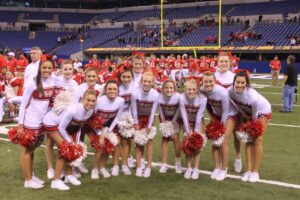
Given the larger size of high schools in our area and the fun, exciting nature of the sport, many athletes participate in high school tryouts. At Fishers High School only 16-24 candidates will make Varsity compared to the many more trying out. Additionally, Coach Thompson notes that they have a fluid program where athletes may be moved between the different squads throughout the season to ensure they are consistently able to perform their skills. With the large competition to make some of these top teams, I recommend mastering as many different high-level tumbling skills years before your first tryout.
For example, standing two back handsprings to full, standing single back handspring to full, standing full, roundoff whip through to full, roundoff full through to full, and Arabian through to full are all passes I know these coaches would love to see! Also, a standing back tuck is absolutely necessary and required at the more competitive schools. Most importantly, being a part of a competitive team helps prepare athletes to be coachable, work well with their teammates, and perform their best under pressure.
Good luck to all of the athletes going through tryouts right now, and I can’t wait to see all of the schools compete in the fall!
